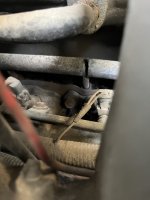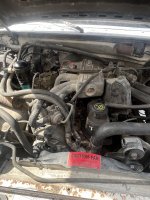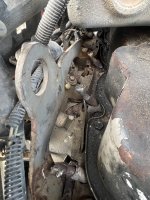Been there, done that! One draw-back to being self employed. Was leased to one trucking company once -a big nation-wide outfit who I will leave unnamed- who had a habit of "holding" big settlements for a week, even though the paperwork was submitted on time. Shorter trips of less $ got paid but the high $ settlements were held. . I did not stay there long.I need some of these checks to come in so i can order some more parts.
You are using an out of date browser. It may not display this or other websites correctly.
You should upgrade or use an alternative browser.
You should upgrade or use an alternative browser.
Mpg tanked again
- Thread starter InlineDave87
- Start date
InlineDave87
Famous Member
Been a minute… So things are warming up again and i had a long road trip last week which started out great. I was doing 66-67 mph, and it was looking like i was going to be getting 25-26 mpg on the first leg of the trip. Then i heard a pop and some ticking. I havent check but im pretty sure one of my manifolds cracked. I got another trip in two days and i got tons of parts for her so i may be digging into her today so i can finally swap the thermostat for the flocooler one i purchased. And while im working on exhaust i might as well throw on the new cat and muffler I got for her as well. Ill update the findings later today.
InlineDave87
Famous Member
Bronctopia
Well-known member
Air injection rail into the heads.
I believe these only are active during cold warmup to pre-burn some of the enriched startup mixture while the catalytic converter is too warm to operate.
Your problem is that it now functions as an exhaust manifold leak aimed at the sensitive plastic injectors and their wiring looms.
I don't think repair is possible with the state of metal there. Pretty sure that was some grade of stainless, but from the looks in your pic, even if you could identify it would it every be clean enough to tig?
Most at this point remove that rail, and either pinch and weld the individual pipes, or remove and plug all the fittings.
I have done the latter before, and if memory serves the threads in the head were 5/8ths fine pitch.
I believe these only are active during cold warmup to pre-burn some of the enriched startup mixture while the catalytic converter is too warm to operate.
Your problem is that it now functions as an exhaust manifold leak aimed at the sensitive plastic injectors and their wiring looms.
I don't think repair is possible with the state of metal there. Pretty sure that was some grade of stainless, but from the looks in your pic, even if you could identify it would it every be clean enough to tig?
Most at this point remove that rail, and either pinch and weld the individual pipes, or remove and plug all the fittings.
I have done the latter before, and if memory serves the threads in the head were 5/8ths fine pitch.
Bronctopia
Well-known member
Should read " while the catalytic is too COLD to operate.". Had some hiccups trying to commit this post.Air injection rail into the heads.
I believe these only are active during cold warmup to pre-burn some of the enriched startup mixture while the catalytic converter is too warm to operate.
Your problem is that it now functions as an exhaust manifold leak aimed at the sensitive plastic injectors and their wiring looms.
I don't think repair is possible with the state of metal there. Pretty sure that was some grade of stainless, but from the looks in your pic, even if you could identify it would it every be clean enough to tig?
Most at this point remove that rail, and either pinch and weld the individual pipes, or remove and plug all the fittings.
I have done the latter before, and if memory serves the threads in the head were 5/8ths fine pitch.
xr650jkallen
Well-known member
A piece of aluminum can with jb weld spread across it and clamp it on with a couple of hose clamps.
Bronctopia
Well-known member
This rail is open to ALL the exhaust ports in the head, with only a check valve further air pumpward to protect the rubber lines.A piece of aluminum can with jb weld spread across it and clamp it on with a couple of hose clamps.
So all of those exhaust valves will allow some exhaust during the supercritical phase of valve opening into that rail during ALL times of operation.
In simple terms, that rail gonna get HOT.
Which is why it appears to have been made from some ferritic grade of stainless.
Have you done this Aluminum can and epoxy repair before, and if so, how many miles has it lasted?
InlineDave87
Famous Member
Poor man fix it is. Looked again this morning and the rear 2 tubes broke off too. So i broke them all off, took the upper intake off, pinched and bent over the tubes going into the cylinder head. Now with all that work i have to fix vacuum lines i broke and replace the gasket for the upper. Otherwise it should be ok with this till so i can get her going again.
Attachments
Bronctopia
Well-known member
When the vacuum lines are brittle enough to break like churros, they were past time to be replaced anyway.
You might find it runs better just from that.
In any case, think of all the future vacuum leak hunting you won't have to do now.
You might find it runs better just from that.
In any case, think of all the future vacuum leak hunting you won't have to do now.
InlineDave87
Famous Member
Bronctopia
Well-known member
I don't think you will have any problems.
The funky looking right angle vacuum valve nexus, connected to that the open hose you have from the air rail you removed is the TAB TAD valve.
It has 3 states.
State 1. blow air to the injector rail you just removed.
State 2. Blow air to the Cat.
State 3. Dump air to the engine bay.
Since it is already dumping air to the engine bay right at that valve, you could probably just cut that hose short and put whatever screen over it works on the mud daubers down your way.
The funky looking right angle vacuum valve nexus, connected to that the open hose you have from the air rail you removed is the TAB TAD valve.
It has 3 states.
State 1. blow air to the injector rail you just removed.
State 2. Blow air to the Cat.
State 3. Dump air to the engine bay.
Since it is already dumping air to the engine bay right at that valve, you could probably just cut that hose short and put whatever screen over it works on the mud daubers down your way.
InlineDave87
Famous Member
I finally got this installed and I love it a whole lot better. My temp rises and while it dips down it doesnt go anywhere lower than the N and it stays between the N and O. Thats even with the board pulled out. Will have to wait till winter to see if it still allows the engine to heat up like normal or if its going to do the same thing.Yeah Dave, if it's running cold the ECM is not calculating. Also, mileage is going to drop in cold air. I say this because you hardly ever get any, but the density difference is 10% and more. Tire pressure is down as much as 10% and more also. . (You guys got a pretty good blast that far south!)
I got a Flowkooler T'stat directly from them. This winter is the FIRST time the '90 has ever not run cold since I've had it. (Big radiator) . Regret not getting a quality one years ago. VERY pleased with it, no comparison to cheepies.

FlowKooler Hi Flow Water Pumps
FlowKooler pumps patented impeller designs help stop engines from overheating and reduces engine temperature up to 30 degrees by doubling the flow of coolant and building system pressure.flowkoolerwaterpumps.com
What temperature flocooler tstat did you install? I have a Bosch mechanical gauge on my thermostat housing fitting. N on the factory gauge reads 195 on the mechanical. O reads 200 and the factory gauge centered reads about 210 on the mechanical.I finally got this installed and I love it a whole lot better. My temp rises and while it dips down it doesnt go anywhere lower than the N and it stays between the N and O. Thats even with the board pulled out. Will have to wait till winter to see if it still allows the engine to heat up like normal or if its going to do the same thing.
InlineDave87
Famous Member
I got the 195 TStat for the 300. And yea my temps are about the same on the dash. So far while cruising it seems to be right innthe middle of N.What temperature flocooler tstat did you install? I have a Bosch mechanical gauge on my thermostat housing fitting. N on the factory gauge reads 195 on the mechanical. O reads 200 and the factory gauge centered reads about 210 on the mechanical.
PSIG
Famous Member
Just a reminder that any gauge, sender or sensor is of unknown accuracy until tested or calibrated, regardless of brand, age or price. Diagnostics rely on good info. I would minimally do a boil test to check accuracy at that one point before using gauge info for troubleshooting. Testing against another gauge of unknown accuracy is no improvement. Trying to help here, as I've spent many useless hours trusting gauges that were lying to me. Hopefully verification saves you time also. 
Dave, my dash gauge is not linear relative to the temperature increase. @180* it's a bit below the N. 195* about where yours is. Borderline overheat, way over 200, the gauge is still only about in the middle of the sweep. the engine would be cooked before the factory gauge read "hot".I got the 195 TStat for the 300. And yea my temps are about the same on the dash. So far while cruising it seems to be right innthe middle of N.
Similar threads
- Replies
- 25
- Views
- 4K
- Replies
- 42
- Views
- 10K
- Replies
- 7
- Views
- 2K
- Replies
- 8
- Views
- 4K
- Replies
- 22
- Views
- 6K




